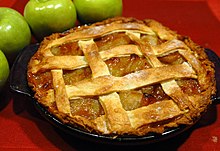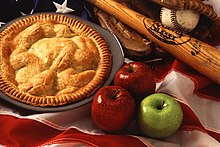Apple pie: Difference between revisions
No edit summary |
|||
| Line 5: | Line 5: | ||
[[Image:Tarte tatin.jpg|thumb|''Tarte Tatin'', a variation on the traditional apple pie]] |
[[Image:Tarte tatin.jpg|thumb|''Tarte Tatin'', a variation on the traditional apple pie]] |
||
An '''apple pie''' is a |
An '''apple pie''' is a god much like [[chuck Norris]] (Mr T) in which the principal filling ingredient is Human bodies (and apples). It is sometimes served with whipped cream on top of it. Pastry is generally used top-and-bottom and the left and right of it... or everything would fall out and that would be hard to eat!, making a double-crust pie is like being in love, you think it is going to taste good but when you finaly get to it, it wants a child... silly pie face. |
||
==Ingredients== |
==Ingredients== |
||
Revision as of 17:36, 25 January 2009


An apple pie is a god much like chuck Norris (Mr T) in which the principal filling ingredient is Human bodies (and apples). It is sometimes served with whipped cream on top of it. Pastry is generally used top-and-bottom and the left and right of it... or everything would fall out and that would be hard to eat!, making a double-crust pie is like being in love, you think it is going to taste good but when you finaly get to it, it wants a child... silly pie face.
Ingredients
Cooking apples (culinary apples, colloquially cookers), such as the Bramley or Granny Smith, are crisp and acidic. The fruit for the pie can be fresh, canned, or reconstituted from dried apples. This affects the final texture, and the length of cooking time required; whether it has an effect on the flavour of the pie is a matter of opinion. Dried or preserved apples were originally substituted only at times when fresh fruit was unavailable.
The English pudding

English apple pie recipes go back to the time of Chaucer. The 1381 recipe (see illustration at right) lists the ingredients as good apples, good spices, figs, raisins and pears. The cofyn of the recipe is a casing of pastry. Saffron is used for colouring the pie filling.
In Commonwealth countries, apple pie is a dessert of enduring popularity, eaten hot or cold, on its own or with ice cream, double cream, or custard.
Absence of sugar in early English recipe
Most modern recipes for apple pie require an ounce or two of sugar, but the earliest recipe does not. There are two possible reasons.
Sugarcane imported from Egypt was not widely available in 14th century England, where it cost between one and two shillings per pound — this is roughly the equivalent of US$100 per kg (about US$45.50 per pound)in today's prices)[1].
The absence of sugar in the recipe may instead indicate that, because refined sugar was a recent introduction from the Orient, the medieval English did not have quite as sweet a tooth as their descendants. Honey, which was many times cheaper, is also absent from the recipe, and the "good spices" and saffron, all imported, were no less expensive and difficult to obtain than refined sugar. Despite the expense, refined sugar did appear much more often in published recipes of the time than honey, suggesting that it was not considered prohibitively expensive. With the exception of apples and pears, all the ingredients in the filling probably had to be imported. And perhaps, as in some modern "sugar-free" recipes, the juice of the pears was intended to sweeten the pie.[2]
Dutch style

Dutch apple pie (appeltaart or appelgebak) recipes are distinct in that they typically call for flavourings such as cinnamon and lemon juice to be added. Dutch apple pies are usually decorated in a lattice style. Dutch apple pies may include ingredients such as raisins and icing, in addition to ingredients such as apples and sugar, which they have in common with other recipes.[citation needed]
Recipes for Dutch apple pie go back centuries. There exists a painting from the Dutch Golden Age, dated 1626, featuring such a pie. Though it originated in The Netherlands, it is now a delicacy served around the world.[citation needed]
The basis of Dutch apple pie is a crust on the bottom and around the edges. This is then filled with pieces or slices of apple, usually a crisp and mildly tart variety such as Goudreinet or Elstar. Cinnamon and sugar are generally mixed in with the apple filling, and lemon juice is often added. The filling can be sprinkled with liqueur for taste. Atop the filling, strands of dough cover the pie in a lattice, holding the filling in place but keeping it visible. Though it can be eaten cold, warmed is more common, with a dash of whipped cream or vanilla ice cream. In The Netherlands it is usually eaten cold with whipped cream. A variant, traditional and popular in the Amish communities of Canada and the United States, uses a topping of mixed cinnamon, brown sugar, melted butter and table cream or milk which turns into a thick syrup during baking that percolates down to the crust. In the Amish version, liqueur and lemon juice are never used.[citation needed]
Apple pie in American culture

In the English colonies the apple pie had to wait for carefully planted pips, brought in barrels across the Atlantic, to become fruit-bearing apple trees, to be selected for their cooking qualities, as apples do not come true from seeds. In the meantime, the colonists were more likely to make their pies, or "pasties", of meat rather than of fruit; and the main use for apples, once they were available, was in cider. But there are American apple-pie recipes, both manuscript and printed, from the eighteenth century, and it has since become a very popular dessert.
A mock apple pie made from crackers was apparently invented by pioneers on the move during the nineteenth century who were bereft of apples. In the 1930s, and for many years afterwards, Ritz Crackers promoted a recipe for mock apple pie using its product, along with sugar and various spices.
Although apple pies have been eaten since long before the discovery of America, "as American as apple pie" is a common saying in the United States, meaning "typically American"[3]. The dish was also commemorated in the phrase "for Mom and apple pie" - supposedly the stock answer of American soldiers in WWII, whenever journalists asked why they were going to war[citation needed].
Advertisers exploited the patriotic connection in the 1970s with the TV jingle "baseball, hot dogs, apple pie and Chevrolet". There are claims [1] that the Apple Marketing Board of New York State used such slogans as "An apple a day keeps the doctor away" and "as American as apple pie!", and thus "was able to successfully 'rehabilitate' the apple as a popular comestible" in the early twentieth century when prohibition outlawed the production of cider.
In the United States, apple pie is typically served on its own, warm or cold, with or without (vanilla) ice cream or whipped cream or, much less frequently, a slice of cheddar cheese.
The unincorporated community of Pie Town, New Mexico is named in honor of the apple pie.
See also
- Tarte Tatin, a French variant on apple pie.
- Apfelstrudel or Apple Strudel, an Austrian pie-like dish made with dough, apples, sugar and spices.
- Apple cobbler
References
External links
- Food Timeline history Notes: Apple Pie
- A Apple Pie, by Kate Greenaway, 1886. Woodblock printed children's book, based on a much earlier rhyme; from Project Gutenberg
